Climate Change Response
Climate Change Response System
Net Zero Declaration
As an energy company, SK Gas aims to meet global demands regarding climate change issues by expanding its business from existing LPG to LNG. Ultimately, SK Gas intends to contribute to opening the Net Zero era through the transition to decarbonized energy sources such as hydrogen and ammonia businesses. In line with the changing Energy Paradigm, SK Gas plans to achieve Net Zero by pursuing a low-carbon-centered Business Portfolio Transformation.
2030 Net Zero Declaration
SK Gas declared its Net Zero commitment in 2021, aiming to achieve Net Zero not only at its business sites but also across its entire value chain, encompassing all greenhouse gas emissions. The company has established ‘Net Zero Operation’ and ‘Net Zero Solution Provider’ as its climate change response strategies. Greenhouse gas reduction performance is disclosed through the Sustainability Report and the company website, with annual progress on reduction plans also made public through participation in GHG reduction initiatives such as CDP*.
- * CDP(Carbon Disclosure Project): A global project requesting information disclosure on climate change issues from companies worldwide on behalf of financial investment institutions (SK Gas first participated in 2021).
Climate Change Response Governance
The ESG Operation Group serves as the working-level organization responsible for establishing climate-related strategies and managing performance. It discusses key climate-related issues with each executing department that implements these strategies. Major content is reported to the Head of the Management Support Division through the Head of Strategic Planning. The Head of the Management Support Division then conveys this information to the C-Level Consultative Body.The C-Level Consultative Body convenes bi-weekly, and the discussed issues are reported to the CEO, who holds overall responsibility for company-wide SHE (Safety, Health, and Environment). The CEO monitors ESG progress, including the status of climate change response, and reviews implementation on a quarterly basis, reporting the findings to the ESG Committee and the Board of Directors.The Board of Directors ultimately receives reports on ESG-related matters, including climate-related risks and opportunities, from the ESG Committee. The ESG Committee's oversight responsibility for climate-related risks and opportunities is defined in the Charter of Corporate Governance and the regulations of each committee.
Organization Chart of the Climate Change
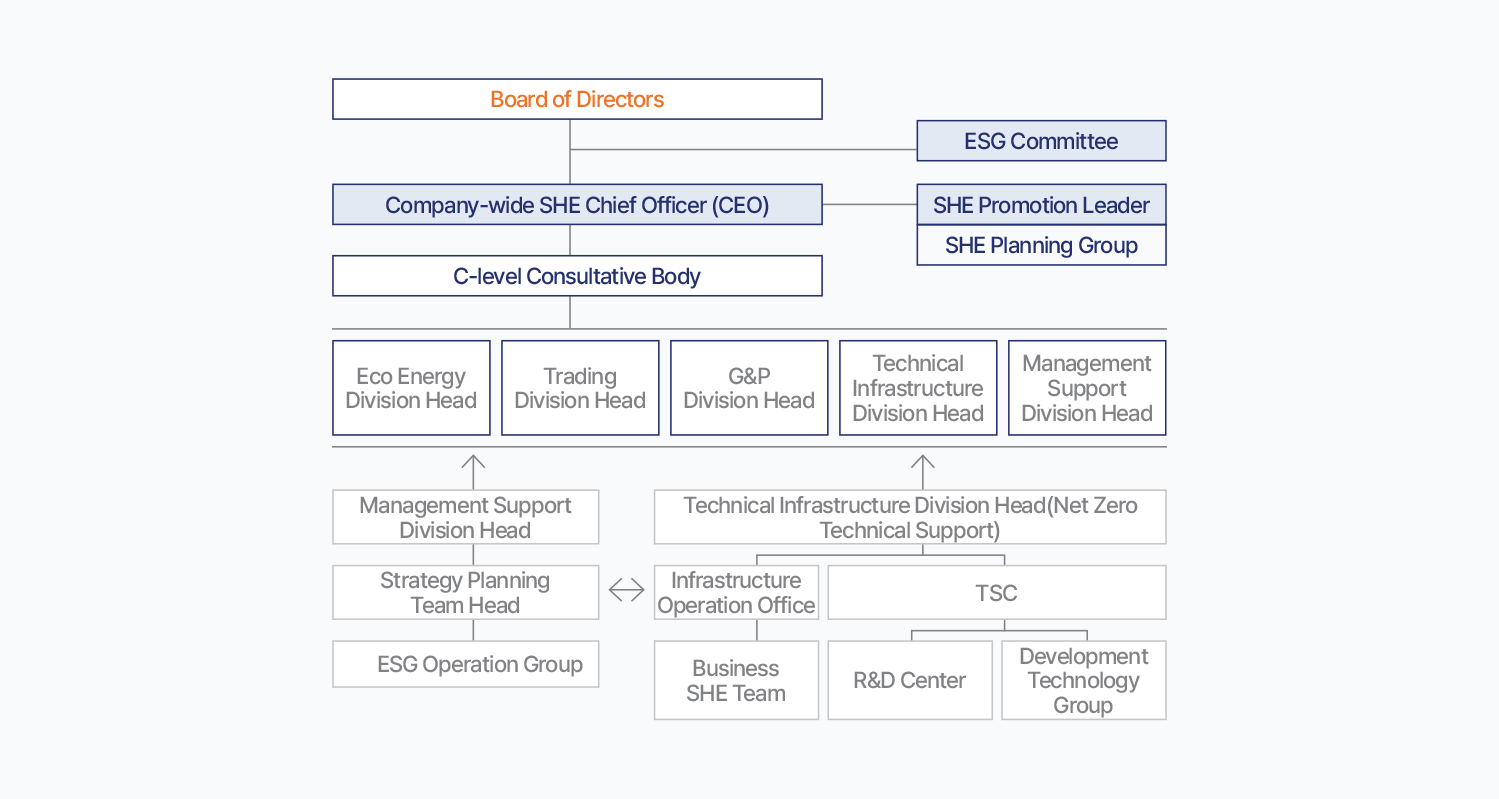
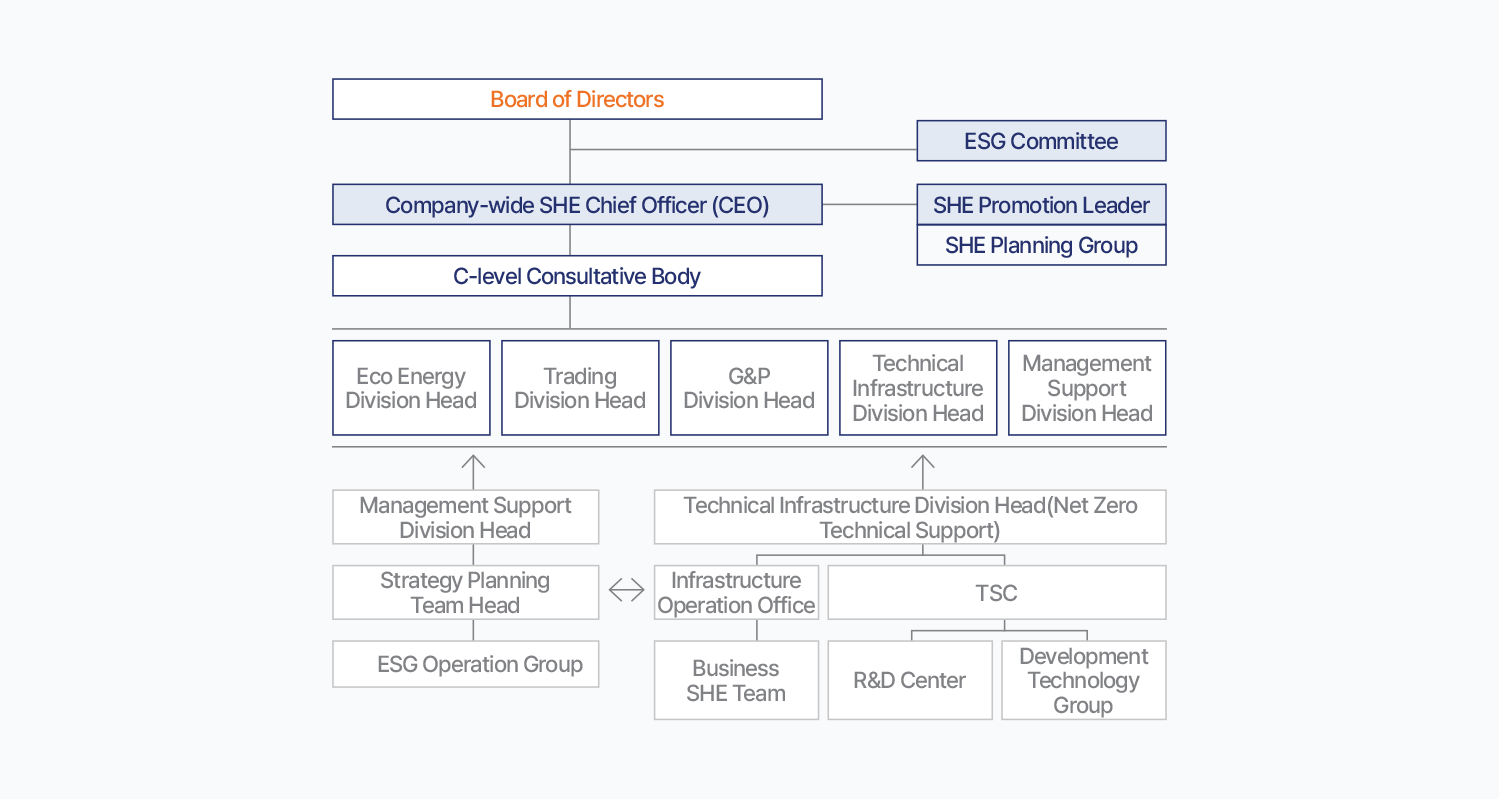
- Board of Directors
- ESG Committee
- Company-wide SHE Chief (CEO)
-
C-level Consultative Body
- Head of Eco Energy Division
- Head of Trading Division
- Head of Solution Division
- Head of Connect Division
- Head of Technology Infrastructure Division
- Head of Business Support Division
-
- Head of Business Support Division
- ESG Operations Chief
- ESG Operations Group
Consultation
- Site SHE Chief (Head of Technology Infrastructure Division)
- SHE Promotion Group (Head)
- SHE Planning Group
- Site SHE Team
Reporting upwards, monitoring downwards
Climate Change-Related Risks and Opportunities
The Board of Directors considers climate-related risks and opportunities across all management activities, including business strategies and financial planning. Management reports investment proposals exceeding a certain scale to the ESG Committee and obtains approval from the Board of Directors. When making investment decisions, the ESG Committee comprehensively reviews investment feasibility from a financial perspective and sustainability factors, including climate considerations, by utilizing OSS (One Stop Support) review reports and ESG checklists. Furthermore, SK Gas is enhancing the process of considering climate-related risks and opportunities by introducing an internal carbon pricing system in its key decision-making processes.SK Gas has implemented the identification and assessment of physical risks to which its business sites are exposed. In accordance with the TCFD (Task Force on Climate-related Financial Disclosures) recommendations, it identifies transition risks and opportunities by business segment based on categories such as policy and legal, technology, market, reputation, resource efficiency, energy resources, and product and service resilience. The results of this identification are reflected in the company's overall business strategy.
GHG Net Zero Strategy
Response Strategy
To realize its vision of ‘Sustainable Energy, Better Future,’ SK Gas is pursuing the ‘Net Zero Operation’ strategy in the short to medium term and has established and is implementing plans to transition into a Net Zero Solution Provider in the long term.
Firstly, the company plans to achieve Net Zero Operation across its overall operations. To this end, SK Gas is establishing climate change governance and strengthening its in-house carbon neutrality capabilities to enhance its level of climate change response. Furthermore, it is promoting process innovation, renewable energy procurement, and energy efficiency improvements to reduce Scope 1 and Scope 2 emissions at its business sites and achieve Net Zero.
In the long term, SK Gas aims to strike a balance between sustainable growth and environmental impact reduction by establishing a strategy to become a Net Zero Solution Provider. It is pursuing a transition beyond LPG and LNG to clean hydrogen and ammonia businesses and intends to minimize its environmental impact by reducing Scope 3 emissions and achieving Net Zero across its entire value chain.
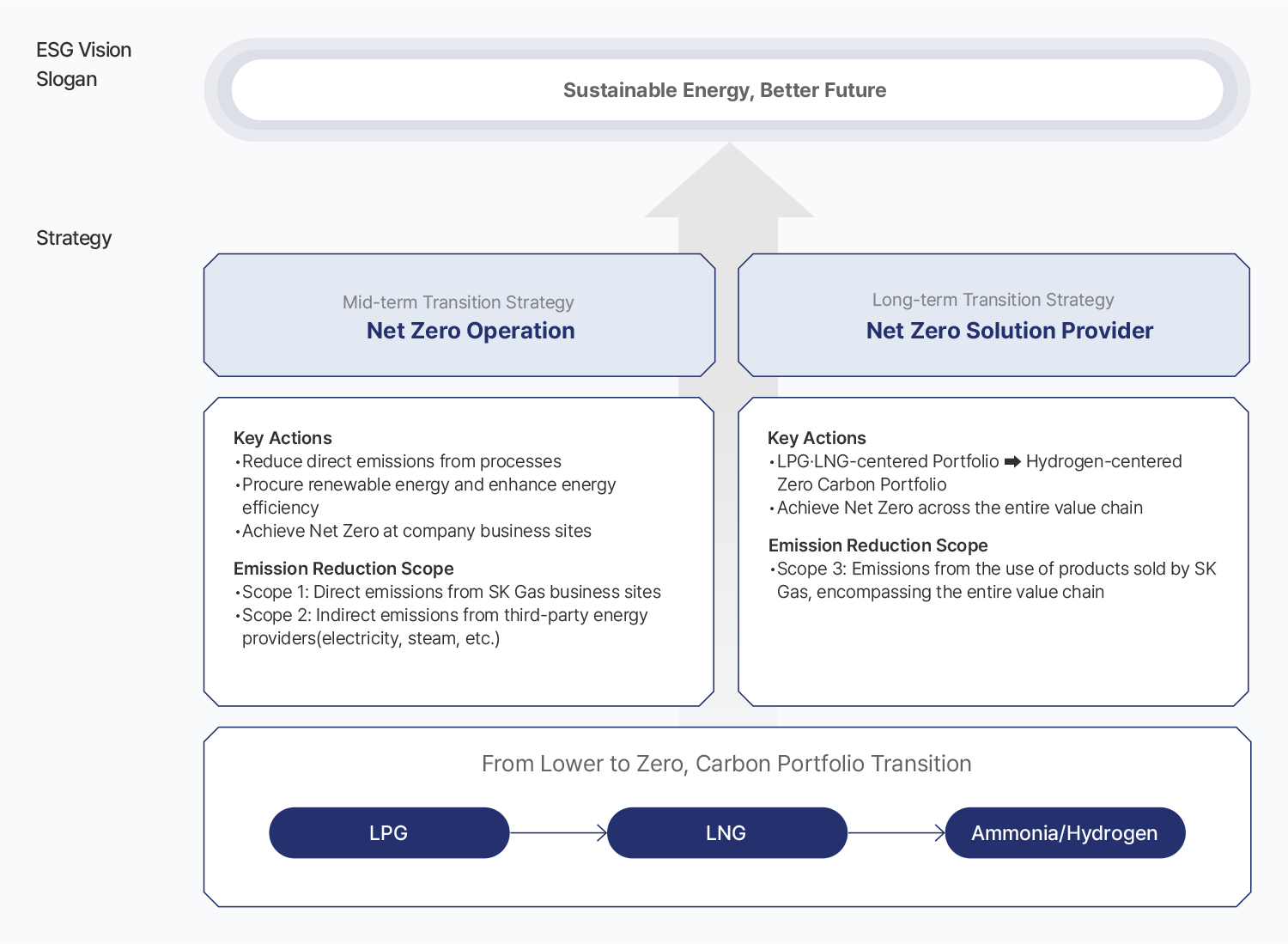
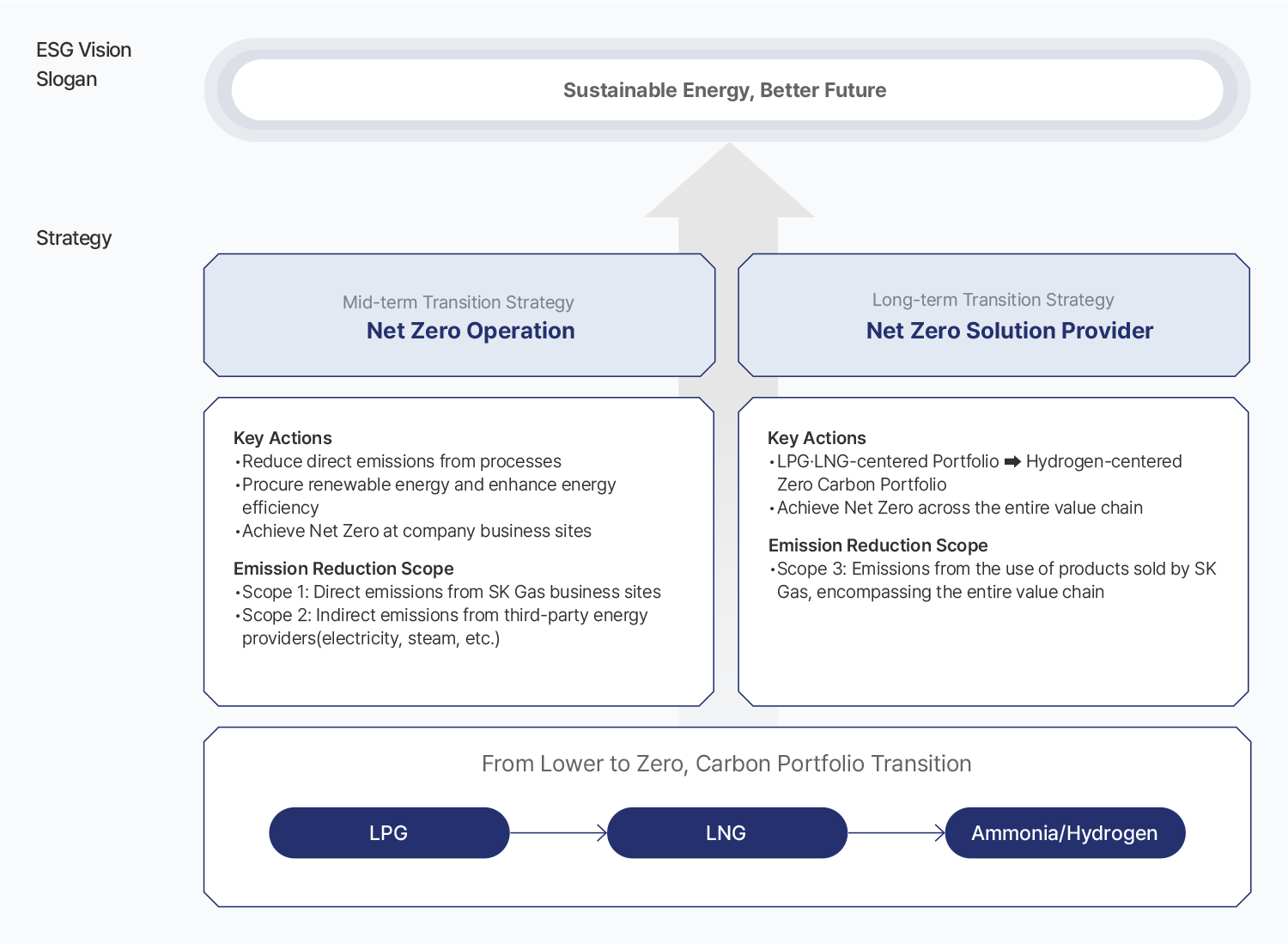
-
Vision: Sustainable Energy, Better Future
-
Strategy
-
1. Mid-term Transition Strategy: Net Zero Operation
- Key Points
- Reduce direct emissions from processes, enhance energy consumption efficiency
- Achieve Net Zero at business sites
- Scope of Reduction
- Scope 1: Direct emissions from business sites
- Scope 2: Indirect emissions from third-party energy (electricity, steam, etc.)
-
2. Long-term Transition Strategy: Net Zero Solution Provider
- Key Points
- Transition from LPG/LNG-focused portfolio to hydrogen-focused Zero Carbon portfolio
- Achieve Net Zero across the value chain
- Scope of Reduction
- Scope 3: Emissions from the consumption of products sold by the company, and emissions across the entire value chain
-
From Lower to Zero, Carbon Portfolio Transition
- LPG: Affordable/Cleaner
- LNG: Reliable
- Ammonia/Hydrogen: Just
-
2030 Net Zero Roadmap
To proactively address climate change, SK Gas has set a goal of achieving Net Zero by 2030 and has been establishing and pursuing annual greenhouse gas emission reduction targets. Furthermore, the company continuously reviews the feasibility of its greenhouse gas reduction pathway, considering various factors such as national policies, the status of reduction technology development, and changes in the business environment. In particular, recognizing the need to reflect the business portfolio changes resulting from its entry into the LNG business in 2024 into its Net Zero roadmap, SK Gas analyzed the technical applicability and economic feasibility of existing reduction measures while exploring new reduction methods to update the roadmap.
As a result of the roadmap update, although greenhouse gas emissions may temporarily increase during the reduction period due to the commencement of new businesses, SK Gas plans to ultimately achieve Net Zero by 2030 by reducing greenhouse gas emissions through measures such as expanding the use of seawater heat exchangers and entering into renewable energy power purchase agreements (PPAs). However, this reduction pathway is based on commercially available reduction technologies as of the report's writing and was established under the judgment that the company's value will improve upon the implementation of reduction measures, based on current energy price forecasts. While SK Gas will continue to make sincere efforts to achieve its set goals, the feasibility may fluctuate depending on future changes in the external environment. In such cases, the company will continuously review and adjust its targets to enhance feasibility.
As of the end of December 2023
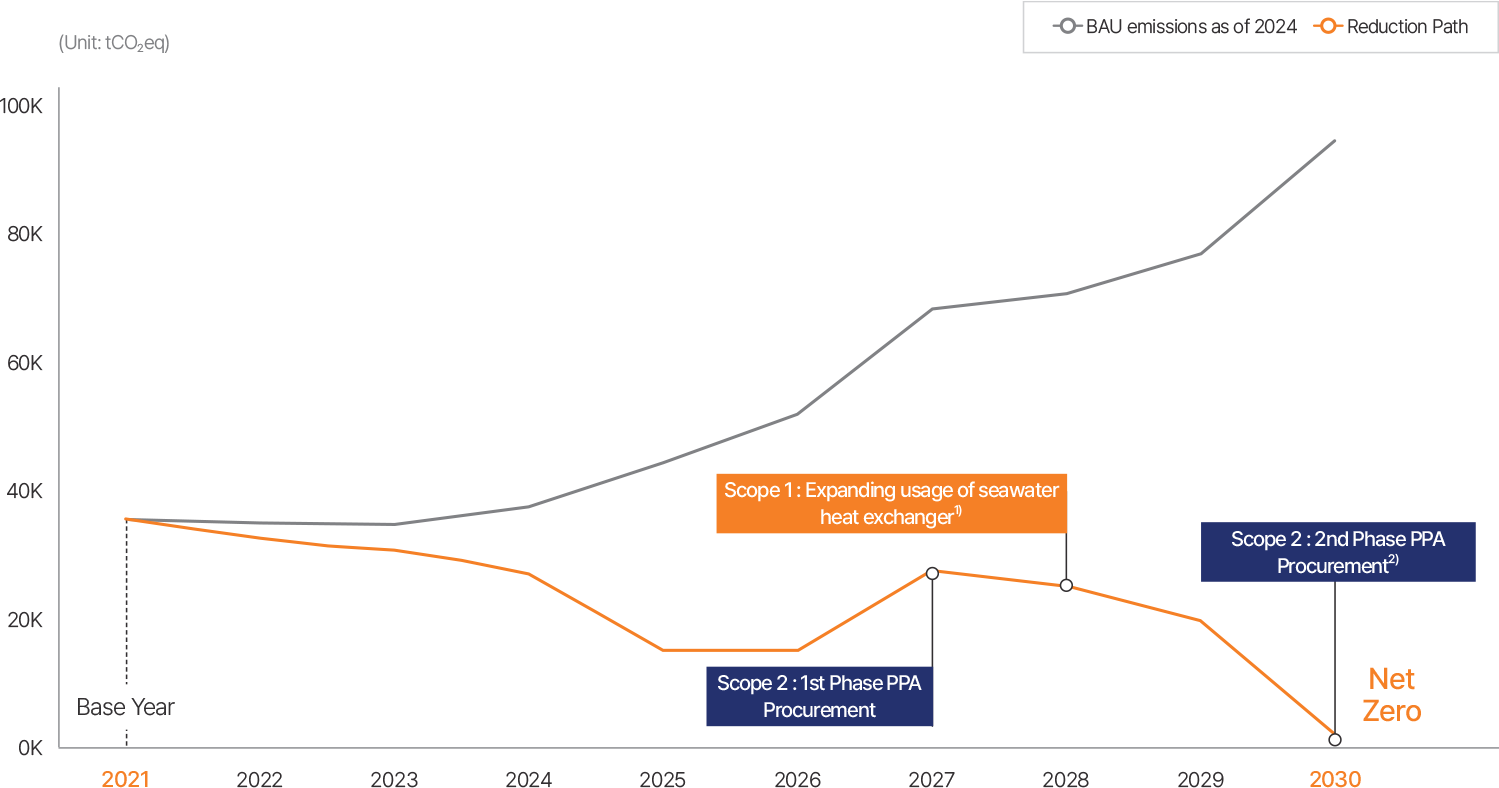
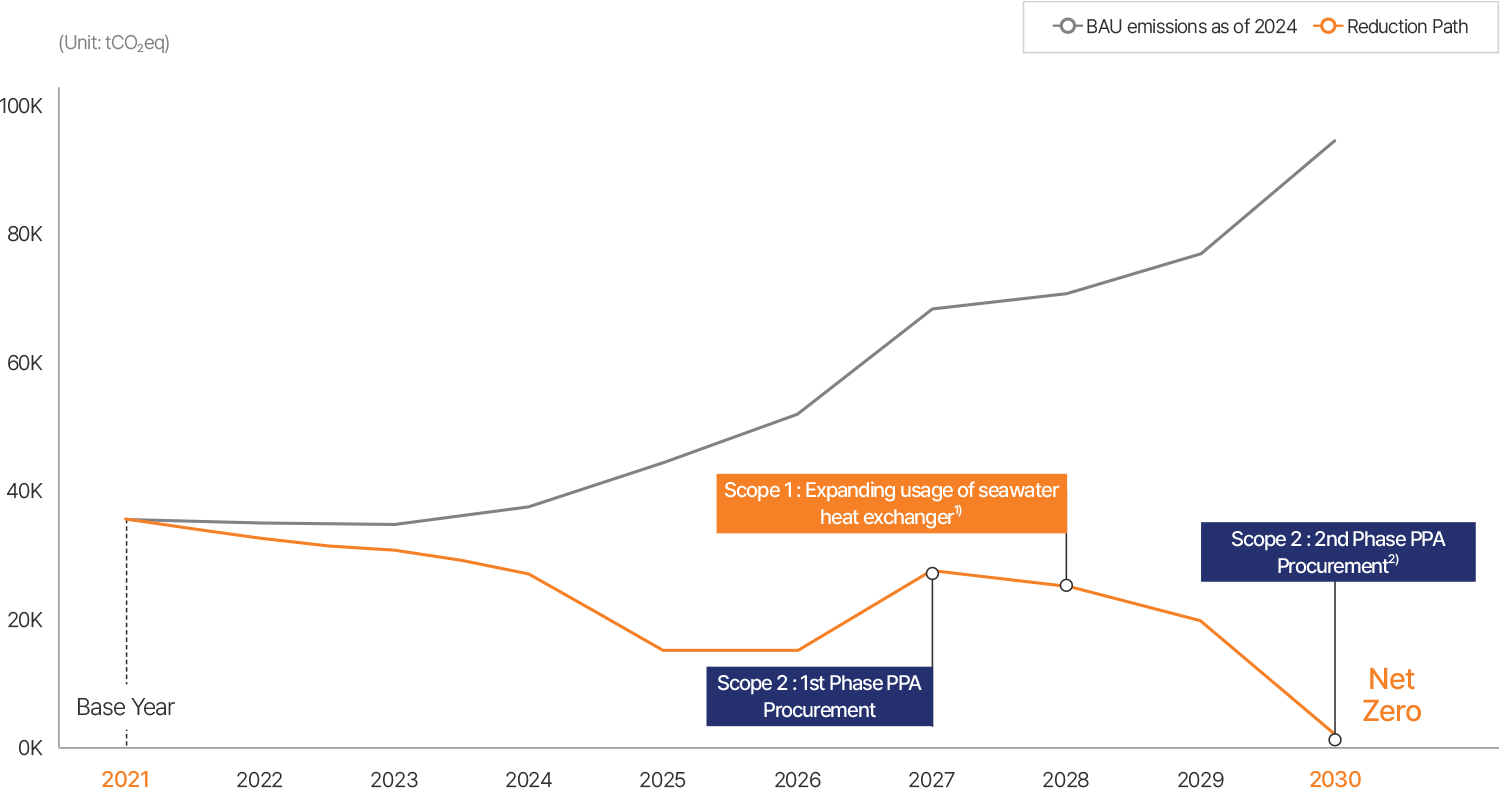
Baseline Year Emission Volume: 35,478 tCO2eq
- 1. LPG Portfolio Transition
- 2. Seawater Heat Exchanger
- 3. First PPA Procurement
- 4. Electric Heater Adoption
- 5. Second PPA Procurement
- 2030 Net Zero Goal (2030)
Baseline Year Emissions (SBTi Standard Reduction), Net Zero Goal, Actual Emissions (2021-2023)
GHG Reduction Activiteis
In its Net Zero implementation process, SK Gas selects greenhouse gas emission reduction and mitigation measures by comprehensively considering technical feasibility and financial costs and benefits to enhance corporate value.
Scope 1 Emission Reduction Activities (Net Zero Operation)
Reducing and Improving Energy Efficiency Through Seawater Heat Exchanger Usage
SK Gas receives imported LPG, which is approximately -40℃, and heats it to 3℃ using a Fire Heater before storing it in underground storage (Cavern). Since this process generates 99% of the total Scope 1 emissions, SK Gas plans to reduce these emissions by expanding the use of seawater heat exchangers. Utilizing seawater heat exchangers allows for the primary heating of -40℃ cryogenic propane to -38℃ to 32℃ before using the heater, thereby decreasing the consumption of propane as heater fuel and reducing greenhouse gas emissions.
Plan to Expand Seawater Heat Exchanger Usage
SK Gas has been utilizing seawater heat exchangers on ships since 2020. In 2024, it additionally installed large-capacity seawater heat exchangers at the CEC (Clean Energy Complex), reducing fuel consumption by approximately 1,223 tons and greenhouse gas emissions by 3,576 tCO2eq. Within the next five years, SK Gas plans to heat all LPG received through its Ulsan and Pyeongtaek bases using seawater heat exchangers. To achieve this, it is proceeding with design, permitting, and consultation procedures with relevant authorities.
Scope 2 Emission Reduction Activities (Net Zero Operation)
SK Gas plans to reduce Scope 2 emissions by decreasing electricity usage and procuring renewable energy. By operating a central control system for air conditioning and heating, it reduces energy consumption and greenhouse gas emissions. Furthermore, it installed solar power generation facilities at its headquarters and three business sites (Ulsan Base, Pyeongtaek Terminals, and G-Hub), reducing greenhouse gas emissions by approximately 205 tCO2eq in 2024. SK Gas plans to secure a power purchase agreement (PPA) for a total capacity of 40MW starting in 2027, ensuring a stable supply of renewable energy to all its business sites for 20 years. Until the PPA agreement is finalized, it is utilizing the Green Premium system.
Scope 3 Emission Reduction Activities (Net Zero Solution Provider)
SK Gas calculates and continuously manages Scope 3 emissions to reduce greenhouse gas emissions across its value chain. In 2024, Categories 1, 10, and 11 accounted for 93.0% of total Scope 3 emissions (based on its own calculation criteria), with emissions from the production of purchased LPG (Category 1) and the use of sold LPG (Category 11) particularly significant. To reduce Scope 3 emissions, SK Gas is promoting the long-term supply of clean hydrogen and ammonia feedstock, aiming to achieve Net Zero across its entire value chain by 2050.
Employee Participation in Greenhouse Gas Reduction
SK Gas utilizes the social value practice application 'Haenggarae' to raise employee awareness of climate change issues and encourage their contribution to greenhouse gas reduction. Employees can earn SV rewards for activities such as taking the stairs instead of the elevator, walking short distances, reducing food waste, and using personal mugs and tumblers. These SV rewards can be used for donations or to purchase products from social enterprises.
Summary of GHG Emission Reduction Programs
| Scope | Emission Reduction Through Energy Efficiency Improvement | Reduction Through Energy Transition |
|---|---|---|
| Scope1 | Fuel Consumption Reduction Through the Introduction/Expansion of Seawater Heat Exchangers | |
| Scope2 | Energy Usage Reduction Through the Implementation of a Centralized Control Heating and Cooling System | Installation of On-Site Solar/Geothermal Power Generation Facilities, Renewable Electricity Transition (PPA Contract and Green Premium)a |
| Scope3 | Employee Participation in Reduction Activities (Haenggarae) | LPG Transition as a Bridge Fuel Promoting the Transition to Clean Hydrogen and Ammonia Feedstock (Long-Term Task) |
GHG Performance
Greenhouse Gas Emission Metrics
SK Gas calculates its Scope 1 and 2 emissions in accordance with the Ministry of Environment's guidelines on reporting and verification of emissions under the Korea Emissions Trading Scheme (KETS) and utilizes the basic emission factors from the 2006 IPCC National Greenhouse Gas Inventory Guidelines, as well as the country-specific calorific values and emission factors for each fuel as notified by the Ministry of Environment. Additionally, SK Gas calculates its Scope 3 emissions for all relevant and significant Scope 3 categories based on the Greenhouse Gas Protocol Corporate Value Chain (Scope 3) Accounting and Reporting Standard (2011).
